Tata Steel Bundle
Can Tata Steel Maintain Its Momentum?
From a humble beginning in 1907, Tata Steel has become a global steel giant, a testament to its enduring growth strategy. The acquisition of Corus Group in 2007 was a game-changer, propelling Tata Steel into the ranks of the world's largest steel producers. This journey highlights the company's adaptability and strategic vision in a constantly evolving market.
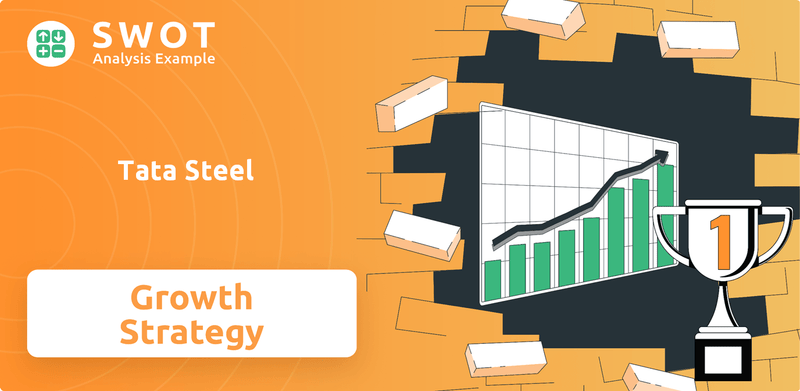
This comprehensive Tata Steel SWOT Analysis will dissect the company's ambitious plans, exploring its expansion strategies and innovative approaches to navigate the dynamic steel industry trends. We'll examine Tata Steel's future prospects, including its financial performance review and its position within the Indian steel market, while addressing the challenges it faces. Discover how the Tata Group is shaping the future of steel production and its impact on the global economy.
How Is Tata Steel Expanding Its Reach?
The Tata Steel growth strategy is heavily focused on expansion initiatives designed to strengthen its market position and diversify revenue streams. A primary area of focus involves significantly increasing its domestic capacity within India. This strategic move is crucial for capitalizing on the rising demand for steel, particularly from the construction, automotive, and infrastructure sectors.
The company's expansion plans are primarily centered around the Kalinganagar project. The aim is to boost the plant's crude steel capacity. This expansion is a key element of the company's long-term growth strategy, designed to meet the growing needs of the Indian steel market. These initiatives are crucial for maintaining a competitive edge in a dynamic industry.
Besides organic growth, Tata Steel company analysis reveals a strategic approach that includes exploring partnerships and acquisitions. These moves are aimed at optimizing its global footprint and improving operational efficiency. The company is also focusing on product diversification, emphasizing value-added products to cater to specialized demands, such as those from the automotive and advanced manufacturing sectors. This demonstrates a proactive approach to adapting to industry trends.
The Kalinganagar project is central to Tata Steel's expansion plans. The company aims to increase the plant's crude steel capacity from 3 MnTPA to 8 MnTPA, with further plans to reach 13 MnTPA. This expansion is critical to meeting the growing demand for steel in India, driven by strong growth in automotive, construction, and infrastructure sectors.
Tata Steel is exploring strategic partnerships and acquisitions to optimize its global footprint. Discussions regarding the future of its UK operations, including potential restructuring or partnerships, highlight this strategy. These actions are part of a broader effort to enhance operational efficiency and adapt to changing market conditions.
The company is focused on increasing its proportion of value-added products and solutions. This shift moves beyond commodity steel to cater to specialized demands from sectors like automotive and advanced manufacturing. Developing new steel grades and enhancing service offerings are key components of this strategy. This strategic move is designed to increase profitability.
Tata Steel is emphasizing the circular economy, aiming for 50% of its steel to be produced via the Electric Arc Furnace (EAF) route by 2045. This involves greater use of recycled steel. This initiative demonstrates the company's commitment to sustainability and reducing its environmental impact. This is a critical component of its long-term strategy.
Tata Steel's expansion strategy is multi-faceted, focusing on capacity increases, strategic partnerships, and product diversification. The Kalinganagar plant expansion is a core element, with plans to significantly increase production capacity. These initiatives are essential for capturing market share and driving future growth.
- Capacity Expansion: Increasing crude steel capacity at the Kalinganagar plant from 3 MnTPA to 8 MnTPA, with a further target of 13 MnTPA.
- Strategic Partnerships: Exploring partnerships and acquisitions to optimize global operations and enhance efficiency.
- Product Diversification: Focusing on value-added products to meet specialized demands from various sectors.
- Sustainability: Aiming for 50% of steel production via the EAF route by 2045, promoting the circular economy.
For a deeper understanding of the company's ownership structure and financial performance, further insights can be found in the analysis of Owners & Shareholders of Tata Steel. This information provides a comprehensive view of the company's strategic direction and its position within the steel industry trends.
Tata Steel SWOT Analysis
- Complete SWOT Breakdown
- Fully Customizable
- Editable in Excel & Word
- Professional Formatting
- Investor-Ready Format
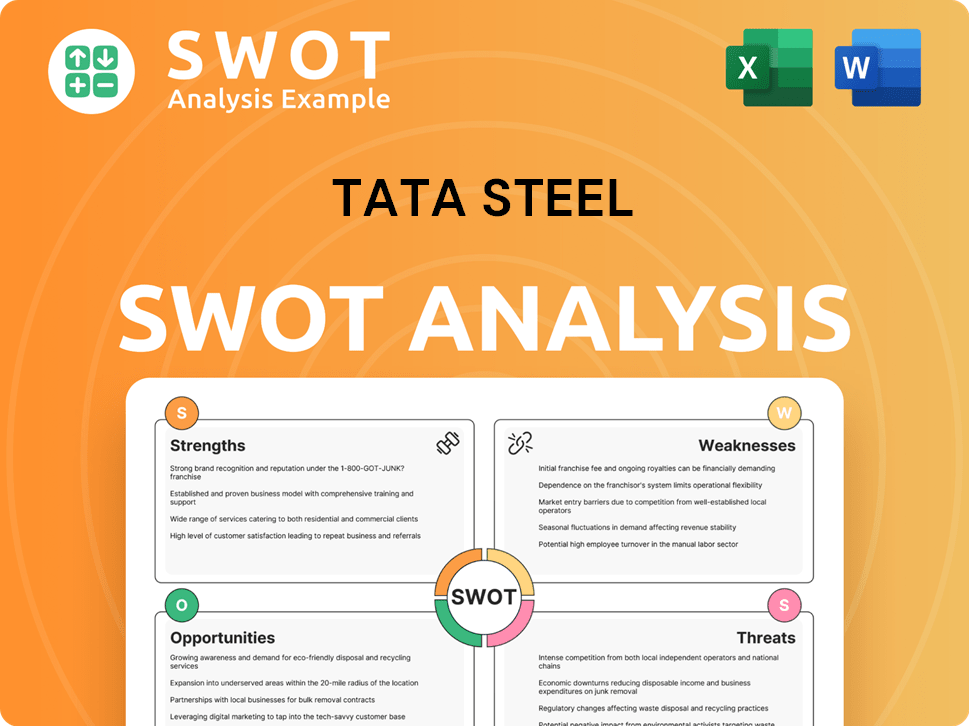
How Does Tata Steel Invest in Innovation?
The company's growth is significantly driven by innovation and technology. This approach is central to its long-term strategy, focusing on digital transformation, advanced manufacturing, and sustainable practices. The company is investing heavily in research and development to create new materials and processes.
A key area of focus is the exploration of hydrogen in steelmaking to reduce its carbon footprint. This aligns with broader sustainability initiatives, including targets for achieving net-zero emissions. The company is also implementing Industry 4.0 technologies, such as automation and AI, to enhance efficiency and improve product quality.
The company's commitment to innovation is evident through its participation in collaborative research and partnerships. These efforts aim to stay at the forefront of material science and manufacturing advancements. This approach is crucial for its future prospects and competitive positioning in the steel industry.
The company is actively implementing Industry 4.0 technologies. This includes automation, artificial intelligence (AI), and the Internet of Things (IoT) across its operations. These technologies enhance operational efficiency and optimize supply chain management.
The company is exploring the use of hydrogen in steelmaking. This initiative is a key decarbonization pathway. It aims to reduce the carbon footprint and supports the company's net-zero emissions targets by 2045.
Significant investments in R&D are made to create new materials and processes. This includes advanced high-strength steels for the automotive sector. These innovations contribute to lighter and safer vehicles.
The company participates in collaborative research projects. It partners with academic institutions and technology providers. These collaborations aim to stay at the forefront of material science and manufacturing advancements.
Industry 4.0 technologies are deployed to enhance operational efficiency. This includes improvements in product quality and supply chain optimization. The focus is on leveraging technology to streamline processes.
The company is known for innovation in advanced high-strength steels. These materials are used in the automotive sector. The use of these steels contributes to lighter and safer vehicles.
The company's focus on innovation and technology is a key part of its Marketing Strategy of Tata Steel. This approach helps the company compete effectively in the Indian steel market and globally. It also supports the company's long-term growth strategy and its role in the Indian economy. The company's commitment to sustainability and technological advancement is crucial for its future prospects and is reflected in its investment in new technologies.
The company's technology strategy includes significant investments in digital transformation and sustainable practices. This is reflected in its financial performance and strategic planning.
- Digitalization: Implementing AI and IoT for operational efficiency and supply chain optimization.
- Decarbonization: Exploring hydrogen in steelmaking to reduce the carbon footprint.
- R&D: Investing in new materials and processes, including advanced high-strength steels.
- Collaborations: Partnering with academic institutions and technology providers for innovation.
Tata Steel PESTLE Analysis
- Covers All 6 PESTLE Categories
- No Research Needed – Save Hours of Work
- Built by Experts, Trusted by Consultants
- Instant Download, Ready to Use
- 100% Editable, Fully Customizable
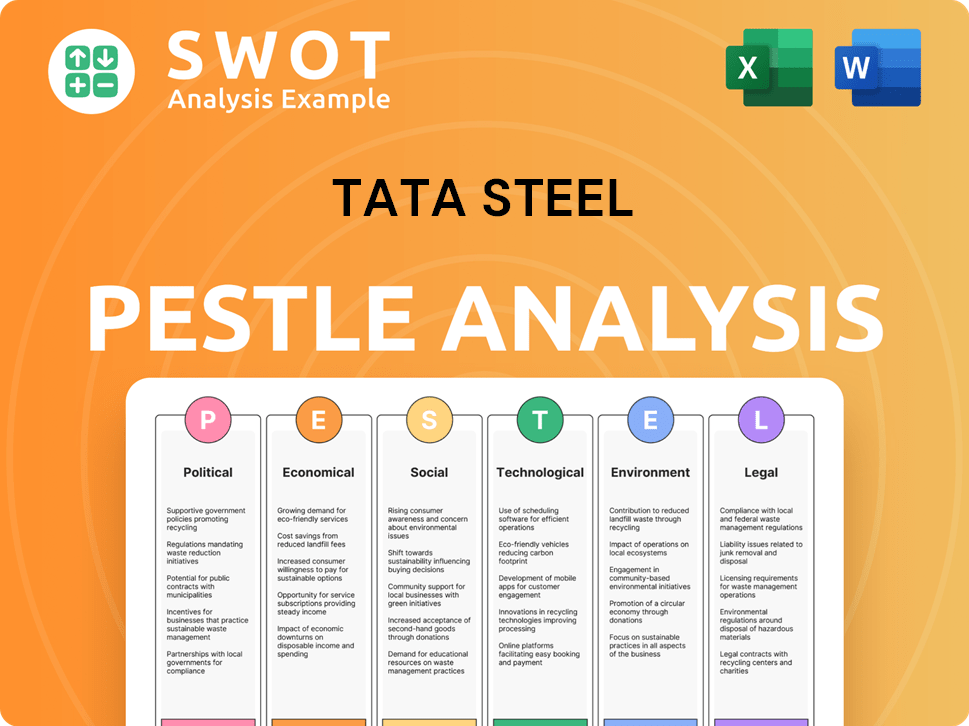
What Is Tata Steel’s Growth Forecast?
The financial outlook for Tata Steel is shaped by its strategic growth plans, which emphasize improving profitability and strengthening its financial position. For the fiscal year 2024, the company reported a consolidated crude steel production of 35.2 million tonnes. Deliveries for the same period reached 34.7 million tonnes, demonstrating consistent operational performance. These figures provide a baseline for assessing the company's financial trajectory and its ability to meet market demands.
In the fourth quarter of fiscal year 2024, the company reported a consolidated adjusted EBITDA of ₹7,570 crore. This financial metric is a key indicator of the company's operational profitability and its capacity to generate cash flow. The company's focus on deleveraging has resulted in a significant reduction in net debt. As of March 31, 2024, net debt stood at ₹55,357 crore, reflecting the company's efforts to strengthen its balance sheet and financial stability.
Looking ahead, Tata Steel is focused on generating healthy cash flows from its operations to fund organic growth projects, such as the Kalinganagar expansion, and further reduce debt. Analyst forecasts generally anticipate stable to improving financial performance, driven by robust domestic demand in India and ongoing efforts to optimize its cost structure and product mix. The company's strategic emphasis on value-added products and sustainable steelmaking is expected to contribute to higher margins and a more resilient financial profile in the long term. For a deeper understanding of the company's core principles, consider reading about the Mission, Vision & Core Values of Tata Steel.
Tata Steel's financial performance in FY24 included a consolidated crude steel production of 35.2 million tonnes. Deliveries were reported at 34.7 million tonnes, showcasing strong operational capabilities. The company's adjusted EBITDA for Q4 FY24 was ₹7,570 crore, indicating robust profitability.
Tata Steel has implemented effective deleveraging strategies to strengthen its financial position. The net debt as of March 31, 2024, was ₹55,357 crore, a significant decrease reflecting the company's commitment to financial prudence. This reduction supports future growth initiatives.
Tata Steel is focused on generating strong cash flows to fund organic growth projects. The Kalinganagar expansion is a key initiative aimed at increasing production capacity. These investments are crucial for long-term growth and market competitiveness.
The company's strategic focus includes value-added products and sustainable steelmaking practices. These areas are expected to enhance margins and build a more resilient financial profile. This approach aligns with industry trends and sustainability goals.
Tata Steel Business Model Canvas
- Complete 9-Block Business Model Canvas
- Effortlessly Communicate Your Business Strategy
- Investor-Ready BMC Format
- 100% Editable and Customizable
- Clear and Structured Layout
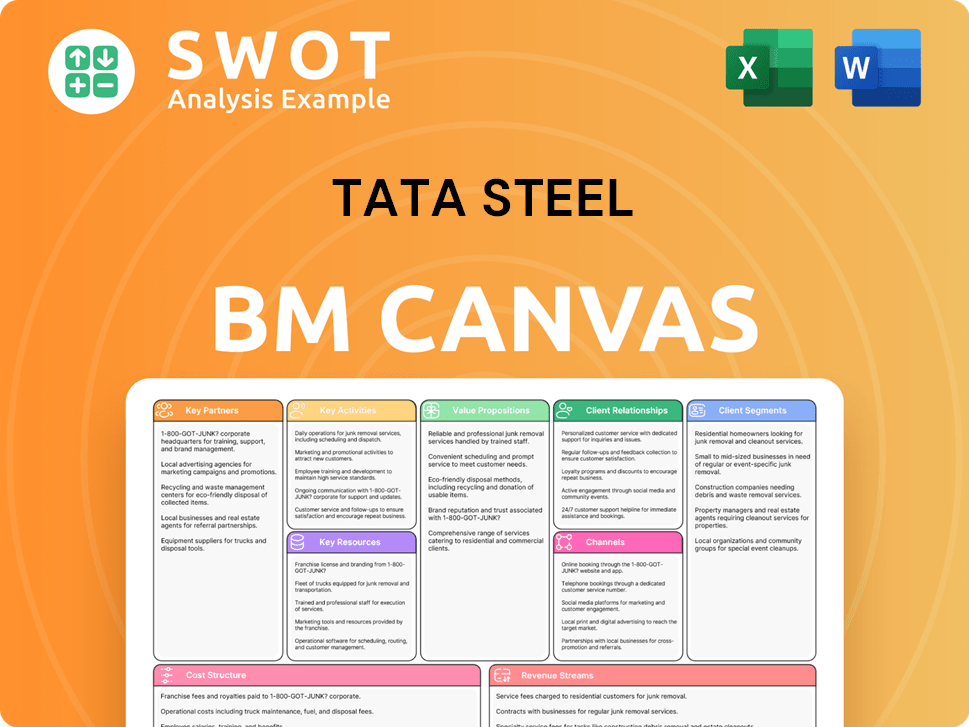
What Risks Could Slow Tata Steel’s Growth?
The Tata Steel growth strategy faces several potential risks and obstacles. These challenges range from market competition to regulatory changes, impacting the company's ability to achieve its future prospects. Understanding these risks is crucial for assessing the overall Tata Steel company analysis and its long-term viability.
Market dynamics and operational challenges are also significant. Fluctuations in raw material prices and supply chain disruptions can affect production costs. Moreover, the company's European operations continue to face structural issues, adding complexity to its strategic outlook. These factors demand proactive risk management and strategic planning.
Technological advancements and sustainability concerns also present challenges. The company must invest in new technologies and address environmental impacts. These investments are vital for remaining competitive and meeting the evolving demands of the steel industry trends.
Intense competition from global steelmakers and increasing imports puts pressure on steel prices and profit margins. This requires Tata Steel to continuously innovate and optimize its operations to stay competitive. The company's ability to maintain its market share in India and expand internationally is critical.
Stricter environmental norms, particularly those related to carbon emissions, necessitate significant investments in green steel technologies. Trade policies and regulations can also impact operations. Compliance with these regulations is essential for long-term sustainability and operational continuity.
Fluctuations in raw material prices, such as iron ore and coal, and supply disruptions due to geopolitical events or natural disasters can affect production costs and operational stability. Managing these risks requires robust supply chain management and diversification strategies. The company's resilience depends on its ability to mitigate these supply chain risks.
Tata Steel's European operations face structural challenges, including high energy costs and legacy issues, leading to ongoing restructuring efforts. Addressing these challenges is crucial for improving profitability and competitiveness in the European market. The company's performance in Europe impacts its overall financial results.
Rapid advancements in steelmaking processes and the development of alternative materials pose a risk if Tata Steel fails to keep pace. Investing in new technologies and innovation is essential to maintain a competitive edge. The company must adapt to stay at the forefront of the steel industry trends.
Increasing focus on Scope 3 emissions and the need for significant capital expenditure to transition to greener steel production methods. This requires substantial investment in sustainable practices. The company's commitment to Tata Steel's sustainability initiatives is increasingly important for investors and stakeholders.
Tata Steel addresses these risks through geographical diversification, a diversified product portfolio, and robust risk management frameworks. Scenario planning and cost optimization also play crucial roles. The company's ability to navigate challenging environments, such as the volatility during the COVID-19 pandemic, highlights its resilience.
The company has demonstrated its ability to adapt to market fluctuations and maintain financial stability. For example, in the fiscal year 2024, Tata Steel reported a consolidated revenue of approximately $29.5 billion, reflecting its market position. However, the company's stock performance can be volatile, influenced by global economic conditions and industry-specific challenges. For a comprehensive view, see this article on Tata Steel's financial performance review.
Tata Steel's long-term growth strategy involves strategic investments in sustainable technologies and expansion plans. The company's focus on cost optimization and operational efficiency is a key factor in its future prospects. The Tata Group's overall strength provides a solid foundation for the company's continued growth.
Government policies, including trade regulations and environmental standards, significantly impact Tata Steel's operations. The Indian steel market is also influenced by government initiatives. Understanding and adapting to these policies is crucial for the company's success. The company's strategic responses to these policies will shape its future.
Tata Steel Porter's Five Forces Analysis
- Covers All 5 Competitive Forces in Detail
- Structured for Consultants, Students, and Founders
- 100% Editable in Microsoft Word & Excel
- Instant Digital Download – Use Immediately
- Compatible with Mac & PC – Fully Unlocked
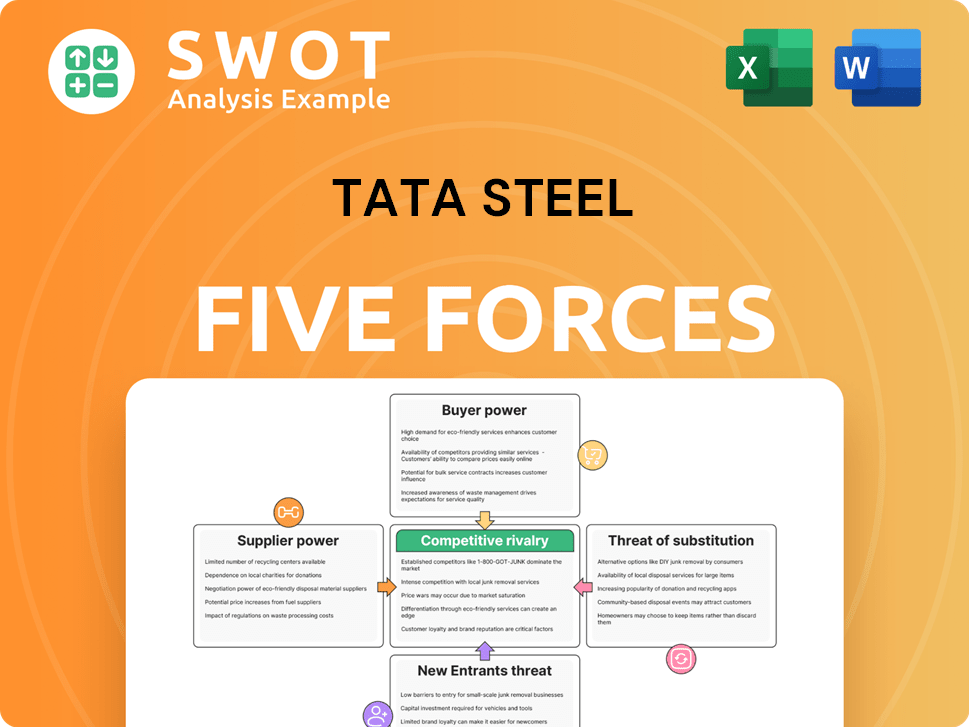
Related Blogs
- What are Mission Vision & Core Values of Tata Steel Company?
- What is Competitive Landscape of Tata Steel Company?
- How Does Tata Steel Company Work?
- What is Sales and Marketing Strategy of Tata Steel Company?
- What is Brief History of Tata Steel Company?
- Who Owns Tata Steel Company?
- What is Customer Demographics and Target Market of Tata Steel Company?
Disclaimer
All information, articles, and product details provided on this website are for general informational and educational purposes only. We do not claim any ownership over, nor do we intend to infringe upon, any trademarks, copyrights, logos, brand names, or other intellectual property mentioned or depicted on this site. Such intellectual property remains the property of its respective owners, and any references here are made solely for identification or informational purposes, without implying any affiliation, endorsement, or partnership.
We make no representations or warranties, express or implied, regarding the accuracy, completeness, or suitability of any content or products presented. Nothing on this website should be construed as legal, tax, investment, financial, medical, or other professional advice. In addition, no part of this site—including articles or product references—constitutes a solicitation, recommendation, endorsement, advertisement, or offer to buy or sell any securities, franchises, or other financial instruments, particularly in jurisdictions where such activity would be unlawful.
All content is of a general nature and may not address the specific circumstances of any individual or entity. It is not a substitute for professional advice or services. Any actions you take based on the information provided here are strictly at your own risk. You accept full responsibility for any decisions or outcomes arising from your use of this website and agree to release us from any liability in connection with your use of, or reliance upon, the content or products found herein.